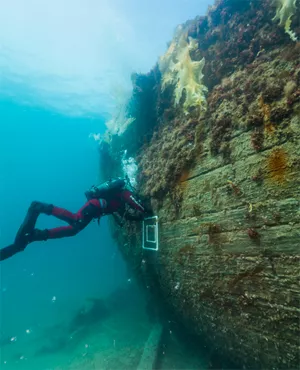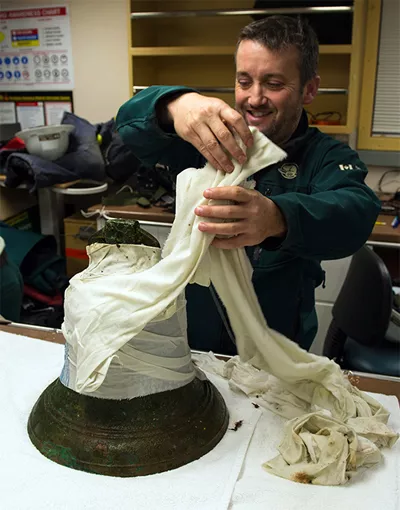
The wreck of the Erebus
When Sir John Franklin and more than 100 sailors from the British Navy set sail in 1845 aboard the HMS Erebus and HMS Terror to discover a Northwest Passage, they had no idea that not one of them would live to tell the story of the expedition. Now, Parks Canada archeologists, in partnership with Inuit communities in the Northwest Territories, have made a start at piecing together their tale, thanks to the 2014 discovery of the wreck of the Erebus.
Jonathan Moore, a Parks Canada senior underwater archeologist, shared some of the excitement and mystery of the search for remains of the Franklin Expedition with the U of T Mississauga community on Feb. 9 at the Chemical and Physical Sciences Colloquium, held in the UTM Instructional Centre.
A bit of the history of the doomed expedition was known before Parks Canada began its quest, thanks to Inuit stories told to the British explorer, Dr. John Rae, in 1854, and a search launched by Lady Jane Franklin, wife of Sir John, in 1859. The latter search located a cairn on Fort William Island with the message that the two ships had been trapped in the ice for about 18 months, during which time Franklin and 23 crew members died. The remaining crew members attempted to make their way south overland, but none survived. The message gave some idea of the location of the ships. The Inuit had attempted to salvage the ships, but they sunk before the salvage was finished.
Parks Canada began a serious search for the lost ships in 2008, using both the crew’s information and Inuit testimony as guides. Crews worked in vain for almost six years, but in September 2014, Moore was one of the four people aboard a small exploration ship that picked up the sonar image of a large object sitting underwater off the coast of Ugjulik, NWT.
“There was jubilation and high-fiving,” Moore said. “We knew within a couple of minutes of seeing the sonar image that we had either the Erebus or the Terror, because the dimensions matched.”
The exploration team made 14 dives to the wreck to explore and confirm its identity.

Since the initial dives, Parks Canada crews have made two additional expeditions to the site, which is now protected as part of the HMS Erebus and HMS Terror National Historic Site, including an April visit that required them to carve a hole in the two-metre thick ice to allow them to visit the wreck.
“The area was frozen over, so we established an ice camp and slept in tents right over the wreck,” Moore said.
Working with Inuit collaborators and other partners, Moore and his colleagues have been able to raise artifacts such as a cannon for conservation.
Moore says, “it is early days yet,” for research into the Erebus. Divers have cleared massive amounts of kelp from the wreck and have mapped some of the lower deck. Artifacts are being researched and analyzed, and the search for the Erebus’ sister ship, the Terror, will continue.
He has high hopes that the Terror will be found and that one of the ships will yield some of the expedition’s secrets in the form of diaries or journals preserved by the cold water. There are many more secrets to uncover, and the final story of the Franklin Expedition is a long way from being written.
